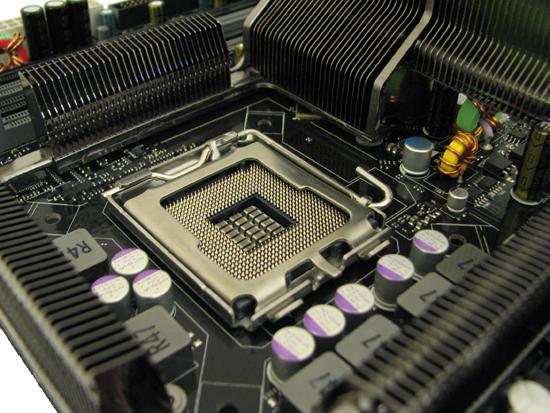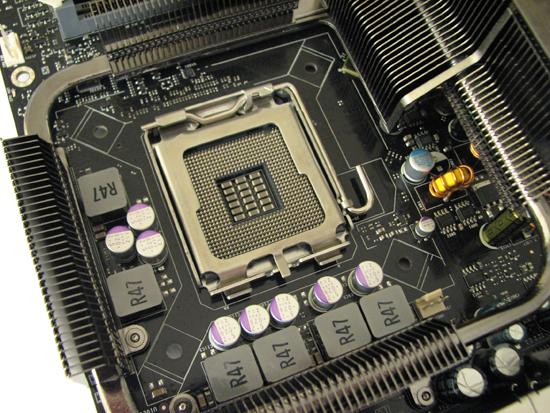NVIDIA's 790i Arrives: SLI Rides Again
by Kris Boughton on March 18, 2008 9:00 AM EST- Posted in
- CPUs
EVGA NVIDIA nForce 790i Ultra SLI Board Layout and Features
 |
EVGA's NVIDIA nForce 790i Ultra SLI motherboard is vaguely reminiscent of their 780i-based product. The first thing you may notice is the size and location of the chipset cooler. Because the 790i SLI SPP now includes native PCIe 2.0 support, the nForce 200 sub-processor included with the 780i SLI SPP is no longer present; removal of this chip provides just enough extra room to move the SPP up and out of the way of an additional PCIe x1 slot seen closest to the backplane. Unfortunately, the added PCIe slot is non-functional when all three x16 lanes are populated with cards. Although the nForce 790i MCP provides up to 60 PCIe 1.x and 2.0 lanes between the SPP and MCP, link configurations rules do not allow for anything more than the cards needed to run 3-way SLI. Those that wish to run their favorite discrete sound card may find themselves out of luck depending on how they fill their expansion slots.
Microprocessor load current profiles have changed to the point that the use of single-phase regulators is no longer a viable option. Nowadays, designing a cost-effective, thermally-sound, and efficient voltage regulator module (VRM) capable of supporting stable, high-speed CPU operations has become a challenge that can only be accomplished through the use of multi-phase converters. However, the consensus amongst most users seems to be that a greater phase count generally results in better, cleaner power delivery - a fallacy which some industry leaders, motherboard vendors, and technical marketing managers are all too willing to promote.



If fact, we submit to you that it's much easier (and cheaper) to slap a few more power delivery phases on a motherboard than it is to create an actual high-performance solution. The quality of a particular power delivery system is primarily dependent on the overall robustness of the design. Design considerations include proper power and ground plane placement; effective signal routing and decoupling measures; selection, location and rated capacity of correctly matched components; and the overall adherence to sound engineering principles. Because of this, the proper design and implementation of a well-developed 5-phase solution can often outperform a lesser 8-phase solution.
The EVGA 790i also uses a true 6-phase PWM controller, where many other boards may make use of 4-phase controllers designed in such a way as to appear to be native 8-phase solutions. Supply-side capacitance has been significantly increased and the main +12V input capacitance has gone way up from only 470uF to 2000uF. This helps overclocking as some cheaper PSUs have higher allowable tolerances when it comes to input current ripple. We say this knowing full well that beyond a certain point additional capacitance matters very little. Often times larger capacitors are used in order to take advantage of their lower equivalent series resistance (ESR), a specification that has a great deal to do with how quickly the capacitor can react to sudden load changes and provide current precisely when needed.
| Motherboard PWM Comparison | ||||
| Intel Spec |
780i | 790i | Notes | |
| Loadline (mohm) | 1 +/- 0.1 | 0.93 | 1.01 | Higher loadline values create more droop |
| Max Icc (A) | 125 | 165 | 220 | High current output supports higher overclocks |
| Max Overvoltage (V) | 1.6 | 1.8 | 2.0 | Higher voltages allow for extreme overclocking |
| Output Ripple (mV) | 10p-p | 9p-p | 6p-p | Less peak-to-peak ripple means "cleaner" power and more stable overclocks |
| Thermal Drift (mV) | +/- 4 | +/- 3 | +/- 2 | Tighter tolerances means that the circuit is less susceptible to variations in component temperatures |
| Phase Jitter (ns) | no spec | 390 | 180 | Less jitter means smoother, more stable power delivery |
| Efficiency | 75% | 82.4% | 83.6% | Higher efficiency allows for cooler components at higher currents and less energy used by the system |
We have listed a few of the more important PWM specifications in order to compare the differences between the 780i and 790i processor power systems. These are just a couple of the more measurable improvements made to ensure ample processor power delivery under even the most demanding situations and to help minimize the detrimental effects of supply-line switching noise and de-stabilizing output ripple. Overclocking places tremendous demands on the power delivery system and without this strong foundation, even your best efforts are sure to fail (particularly in the case of long-term overclocking).
NVIDIA also recognized the need for a more capable power subsystem cooling solution due to the tremendous current draw of 45nm CPUs experienced during aggressive overclocking. The heatpipe has been extended to encompass both sets of MOSFET banks, including an extra segment of fins used to close the circle and provide additional surface area for maximum heat dissipation. The heatsink assembly is made entirely of aluminum, except for the steel casing used to hold it together, and the included fan can be used to provide active cooling when pushing the board to its absolute limits. The fan speed can also be manually adjusted in the BIOS if you find the whine at full-speed to be a little over the top.










19 Comments
View All Comments
ATWindsor - Wednesday, March 19, 2008 - link
I couldn't agree more, features is all well and good, but only if things works and are stable. No wonder people find it daunting to build a computer, even when you have done it several times you risk going into som "trap" with things not working the way it should, more focus on this in reviews please.AtW
theYipster - Tuesday, March 18, 2008 - link
I agree with Lopri in every regard. AT needs to stop masquerading these technical showcase articles as reviews. In addition to what Lopri already mentioned, I would add that AT failed to a) address the long standing concerns held throughout the enthusiast community over nForce product quality (regarding the paragraph on PWM design... very undwerwhelming considering that it doesn't offer support to its claim) and b) failed to provide a fair assessment of the value proposition these boards provide. The article states that the 790i provides a noticeable step up in performance over previous generations, and that owners of previous boards would find upgrading worthwhile. This is a bold claim, as such an upgrade would cost nearly $1000 (when factoring in new DDR3 RAM) and would not even include a new CPU or graphics card. Yes, the NB runs a bit cooler and can OC a bit farther, but how and why is that worth $1000, even to the enthusiast who can afford it easily? Lets also consider the grander scheme of things. What worth is it for someone who enjoys the latest and greatest to spend $350 on a board when Nehalem will change all the rules in less than a year. At least previous generations (as well as Intel's X38) provide some shelf life.In any case, Overclock3d.net has a very informative review of the Striker II Extreme which covers almost everything Lopri mentioned.
ssiu - Tuesday, March 18, 2008 - link
"The EVGA 790i Ultra also handled our QX9770 sample with relative ease. We were able to benchmark and play games without incident at 400MHz FSB, our mark of excellence when it comes to quad-core overclocking."That is a low standard of excellence for a high-end chip. The Q9300/Q9450 overclockers are going to cry.
greylica - Tuesday, March 18, 2008 - link
Mwahaha, some will say :" Now we can finnaly play crysis ! "
Well done, 66 fps...
n0nsense - Tuesday, March 18, 2008 - link
We can for a very long time.I do it with 1920x1200 at all Med + 4AA
I have the 680i (P5N32-E SLI) + E6300@2.8GHz (not the maximum, but lower fan speed = less noise) + 4GB OCZ ReaperX @ 800MHz 4-4-3-12 1T and single reference design 8800GT from ASUS at stock clock (the only modified sing, is stock cooler replaced with Arctic Cooling Accelero S1 which reduced card temp by 25C)
As you can see MB - year old, CPU 1.5 years old.
I can't tell you the exact fps, but it's completely smooth playing.
I expect next generation to bring same smooth play at all very high + all filterings for existing games.
BTW, where 9800x2 in SLI tests on this 790i ?
SpaceRanger - Tuesday, March 18, 2008 - link
When do you think nVidia will be putting out these boards for AMD CPU's. The only thing I see for AMD CPU's are boards that support CROSSFIRE, but not SLI.ap90033 - Tuesday, March 18, 2008 - link
It just costs to MUCH. I got 8 GIGS DDR2 800 an E8400 and a Single 8800GTS 512 meg, and I have the CPU Running at 3.6 (I am looking to try 3.8 maybe) and I can play any game maxed except Crysis. I can play it at high at 1024x768. I looked at SLI but its to danged expensive, I had 1220$ to spend and decided to get the most performance for the money. I wish they would quit going up in price on these motherboards, hey Nvidia, you do know I can get a GREAT Overclockers motherboard with good features (NO SLI OF COURSE) for $80 right? Why would I pay $250+ more for the board, another $200+ more for DDR3 Ram, and another $250 for another 8800GTS just so "some" games would run 15% faster? Are you nuts??? 10-15% but it costs like $800 MORE???? I think Ill save my $800 or so and use it on my next video card upgrade, my next CPU upgrade, and the next video card upgrade after that! LOLkrnmastersgt - Tuesday, March 18, 2008 - link
Because this isn't meant at the people that want the best price/performance, this is for the uber-high end user, the extreme benchmarker/extreme gamer, of course by your logic SLI and CrossFire are stupid wastes of money since the performance doesnt scale linearly, but this is meant for enthusiasts and therefore you shouldn't compare it with something like a P35 board.crimson117 - Tuesday, March 18, 2008 - link
As an example, I was helping configure a Dell for a home office user, non-gamer, no video editing, etc, but he was fairly well-off money-wise. While picking options, at one point I said something about some component being "plenty for most users" and he replied (in a nice way) "I'm not most users"; so we went with the upgraded version even though the price performance, especially for his usage pattern, didn't make fiscal sense.The moral is there are people out there who get satisfaction over having the absolute best no matter the price.
Relatedly, an experiment found that people perceive $90 wine as tasting better than $10 wine, even when it was secretly http://www.news.com/8301-13580_3-9849949-39.html">the same exact wine.